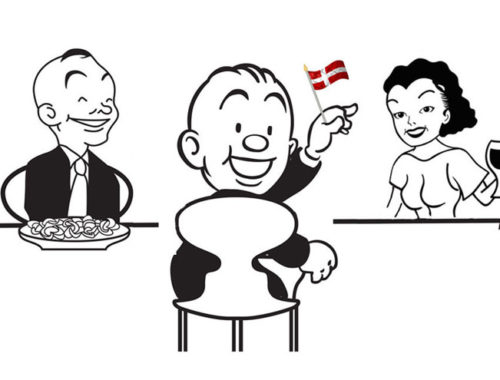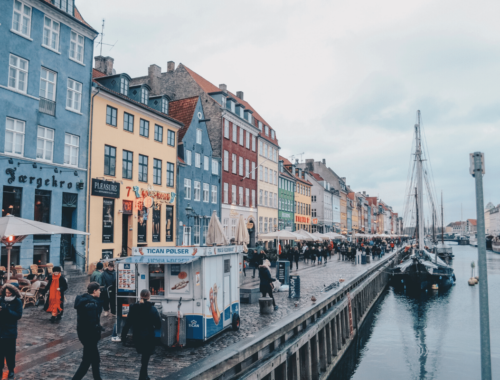I’ve referred to “The Danish Year” before on How to Live in Denmark. It’s a series of events that are simply expected to happen every year in Denmark, even if they aren’t formal holidays. In 2025 I’m going to try to do a podcast every month about aspects of the Danish year, and how they fit into the overall context of where Denmark is coming from, and where it’s going.
August in Denmark is the beginning of fall. The summer strawberries disappear from the supermarket, the leaves start to turn brown on the trees, and the primary schools open again, after their usual brief six-week summer vacation.
This month some young Danes will be starting school for the very first time. They’re usually welcomed with a ceremony that includes Danish flags, speeches, and songs, and their parents, who take a lot of photos of the first day of school.
This was something I unfortunately didn’t know when my own daughter had her first day of school in Denmark. She’d already been going to playground classes there, so on the first official academic day I just dropped her off at school as if it were an ordinary day, and there nobody there to take her picture.
Such is being a foreigner and not knowing the local customs. She still brings it up to this day.
Anyway, it’s hard to understand Danish culture without understanding early Danish childhood education, which doesn’t just begin in school – it begins in infancy.
Almost every child enters Danish day care at 12 to 18 months, after their parents finish their one-year childbirth leave.
Danish day care isn’t free
Day care isn’t free – it costs up to 5000 kroner a month in Copenhagen, about 800 US dollars – although the price is lower for low-income people and day care is actually mandatory for some of the poor.
If you live in a district that the Danish government has listed as socially marginalized, poor districts which usually have a high immigrant population, your child must attend day care for at least 25 hours a week in order to receive your “child check” welfare payments.
This is so all kids learn the Danish language and Danish values, right from the start.
What are those values?
What are those values? Independence, self-sufficiency. You learn to put on your own shoes and jacket.
Responsibility – you learn how to clean up after yourself.
You learn group spirit, inclusion.
You learn conflict resolution, empathy.
Academics can wait
Preschools in Denmark don’t teach kids to read, and often don’t even teach them letters and numbers.
That doesn’t happen until they start school at age 6, and Danish kids generally don’t learn to read until they are 7 or 8 years old. Basic math has to wait as well.
Denmark spends resources on kids
I’ve been spending a lot of time with Danish children lately. I make my living giving speeches to corporate groups or academics, but in the summer I like to take on other jobs and experience Danish working culture from the inside, something to keep my knowledge fresh as an expert on Danish working culture.
This summer I’ve been working at several kindergartens that serve ages 3 to 6, my favorite age. They’re old enough to be verbal and express interesting ideas, but not so old that they are flabet, which is the Danish word for “sassy” or talking back.
The Danish government spends enormous resources on kids, in particular preschool kids.
One of the preschools where I work, owned by the Copenhagen municipality, is built for just for that purpose, with high ceilings and big windows, a seemingly infinite amount of toys, five separate playgrounds with trees and sandboxes, a pillow room for jumping around on rainy days, a well-equipped art room, and an extensive kitchen to prepare meals.
One day this summer we had a very nice baked salmon with rice and broccoli, followed by a snack of fresh strawberries, granola, and yogurt.
“Educational eating”
We adults practice “educational eating” which means we eat lunch with the small children to work on table manners and appropriate table conversation, always important in Europe.
It’s important to talk about things interest everyone, like what’s your favorite ice cream, or which is better – trains or motorcycles?. We teach them to avoid chatter about things that are only interesting to you, like my pants are so wet. That’s not good table conversation.
Of course, I made the mistake of leading a one-sided conversation myself once. We were talking about masks, and I mentioned masks in the context of the COVID lockdowns, before realizing that I was the only person at the table who had been born during the COVID lockdowns.
Danish population is now 6 million
Denmark is a very good place to be a child, and to have children, yet the birthrate is dropping as it is in so many other countries. Some day cares have shut down due to lack of kids.
Just this year Denmark recently reached a population of 6 million – a big landmark for a little country – but that’s mostly due to immigration, not more children being born.
All the initiatives that people recommend for increasing fertility in other countries, like child checks for parents, long parental leaves after childbirth, good universal day care and tax-funded health care, already exist in Denmark, and yet fertility is well below replacement levels, at about 1.5 children per woman in 2024.
The Danish government even offers free fertility treatment for the first and second child, and it offers this to single women as well as committed couples. You really couldn’t do more.
Why are there not more babies? My guess is long educational requirements for both men and women – you really can’t get anywhere in business without a masters’ degree – plus high housing prices in the big cities.
Denmark is a child-friendly culture
But, bottom line, Denmark is still a very child-friendly culture.
There is nothing more Danish than a long line of small children on a field trip from kindergarten, walking along the sidewalk in their bright vests, each holding hands with a buddy while adults desperately corrals them to make sure they don’t run into traffic.
I’ve been one of those adults, and it’s amazing how many smiles and waves we get from passerby, kids just a few years older who remember their own kindergarten days, or old ladies hobbling along on their canes, or workmen in vans who pause during their busy to make sure all the children have crossed the street safely.
Denmark likes kids, even if there are fewer of them these days.




